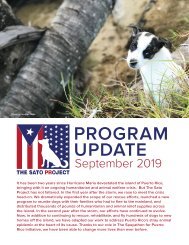Celebrating 10 Years of The Sato Project
When The Sato Project was founded in 2011, our work began by rescuing one dog at a time from Dead Dog Beach. 10 Years later we have flown and vetted over 6,000 dogs from the streets and beaches of Puerto Rico to loving homes on the mainland. We have also spay/neutered and vaccinated over 7,500 animals and distributed 136K lbs of disaster relief supplies across the island in the wake of Puerto Rico's multiple natural disasters. None of these accomplishments would have been possible without the support of our #satostrong community. Read this special edition 10th Anniversary Program Report for The Sato Project's full story.
When The Sato Project was founded in 2011, our work began by rescuing one dog at a time from Dead Dog Beach. 10 Years later we have flown and vetted over 6,000 dogs from the streets and beaches of Puerto Rico to loving homes on the mainland. We have also spay/neutered and vaccinated over 7,500 animals and distributed 136K lbs of disaster relief supplies across the island in the wake of Puerto Rico's multiple natural disasters. None of these accomplishments would have been possible without the support of our #satostrong community. Read this special edition 10th Anniversary Program Report for The Sato Project's full story.
Create successful ePaper yourself
Turn your PDF publications into a flip-book with our unique Google optimized e-Paper software.
As if the earthquake crisis of 2019-2020 was not enough,
2020 also brought with it the emergence of the COVID-19
pandemic. With vital infrastructure still damaged from
Hurricane Maria, thousands of families sleeping outside in
encampments, and a very fragile and underfunded hospital
system, the government of Puerto Rico knew that the island
could not handle a COVID-19 outbreak without devastating
consequences. Governor Wanda Vázquez Garced was the
first governor in the country to order a statewide shutdown.
This swift action likely prevented an even worse healthcare
crisis; however, the economic catastrophe that followed
has been compared to the economic crisis that followed
Hurricane Maria.
For as long as The Sato Project has been doing work in
Puerto Rico, the poverty rate has been more than double
that of any state on the mainland. The latest census data
including Puerto Rico which measures the national poverty
rate is from 2019. On the mainland, Mississippi showed the
highest poverty rate at 19.6%. In stark comparison, Puerto
Rico had 43.5% of its population living below the poverty
line, including 57% of households with children. Updated
data including Puerto Rico has not been published for 2020
or 2021, yet both of these numbers are expected to be
much higher than before the pandemic.
Puerto Rico has since reopened, and as of fall 2021, tourism
and other industries have started to pick back up. However,
like the rest of the world, this status remains uncertain as the
pandemic is far from over and each day brings new changes.
Amidst declining economic circumstances, crumbling
infrastructure, ongoing earthquakes, the pandemic, and
Photo by Myritza Castillo
Over 10 years, our incredible community of donors,
volunteers, and adopters have helped us ensure that
the satos of Puerto Rico will never be forgotten.
more, there is another looming threat that is never too far
from the backdrop: the threat of more hurricanes.
As human life is continually disrupted, the suffering of
thousands of animals is exacerbated as well. The Sato
Project team remains as committed as ever to our mission to
save as many of these lives as we can. We are determined
to be a voice for the thousands of abused and abandoned
dogs who need us. Through hurricanes, earthquakes,
public health crises and more, we will never stop fighting
for them.
THIS IS THE BACKDROP OF THE
SATO PROJECT’S RESCUE EFFORTS
Photo by Sophie Gamand
The estimated number of stray dogs roaming Puerto Rico’s streets and
beaches remains around at least 500,000. The island’s five municipal
shelters all maintain an astounding combined euthanasia rate
of 94% or higher.
13





